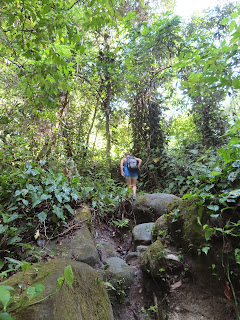April 18-19
Hello everyone!
The pun here is to sing “I’m a Believer” by The Monkees, replacing ‘believer’ with ‘Boh-LEE-vuh’, which is how you say the famous general’s name. So clever. I think the humidity might be getting to me…
My second trip to Colombia in 2025 is very different to visiting Bogotá in January. A huge height difference, for one. The capital is about 2,600 metres above sea level. Where we arrived after leaving Panama is about…maybe 5 metres above the Caribbean Sea?
 |
| Sunset on Santa Marta's main beach |
 |
| Statue of Simón Bolívar in the hacienda where he died |
Welcome to Santa Marta, a city on Colombia’s Caribbean coast. It’s actually closer to Panama City than Bogotá. The climate is much closer as well: that is, very hot and very humid. It is peppered with reasonably tall hotel and apartment blocks, reflecting its popularity as a beach destination and the transport hub for getting to some of Colombia’s more remarkable sights.
 |
| The marina has a lot of money in it |
 |
| The nearby hills shows the plethora of tall towers |
We had been warned to be vigilant when in Santa Marta. The city made the news for the wrong reasons recently. It was thus slightly unnerving when we arrived in what was a ghost town. We soon discovered why. Everyone was at the beach. It might be a public holiday for Good Friday, it might be a continuation of celebrations of the city’s 500th birthday - either way, the masses were splashing and sipping in the late afternoon sunshine, which was lovely to see.
 |
| Santa Marta is Colombia’s oldest city |
 |
3rd Street - Carrera 3 - is pedestrianised
and has many bars and restaurants |
Aside from one man jumping up and down in front of me in a narrow street on my morning run on the Saturday, I felt fine in Santa Marta. It’s the usual thing: take obvious precautions like not flashing watches and phones around, taking Ubers at night and so on, whilst remembering that there is a lot of crime in other cities which doesn’t get mentioned so prominently in the media.
 |
| Kayeye is a local dish made from guineo, from the banana family |
 |
| 7am mass fitness workout on the beach! |
We were only here for one night before moving on. When researching Santa Marta, I found out that it was the place where Simón Bolívar died. A name that I knew was important here, but a person I knew little about. The hacienda - a large estate - where he died is on the outskirts of the city, and a surprisingly pleasant place.
 |
The hacienda was owned by the De Mier family
|
 |
The buildings are from the eighteenth century |
Partly this is because the first section of the hacienda is in fact a botanical garden. It contains a wide variety of trees and cacti - more than 40 species. The palm trees were particularly impressive.
 |
Mexican palm a symbol of victory, triumph…and peace |
 |
Many cacti are used for medical purposes - this one has natural antiinflammatories |
The buildings beyond didn’t belong to Simón Bolívar. The estate belonged to a Spanish landowner who invited him to stay to recover from an illness in 1830. That illness, contrary to what controversial politicians might say, was tuberculosis. In 1830, that was close to being a death sentence. He died aged 47.
 |
| This is apparently what Bolívar looked like when 'lying in state' |
 |
The clock shows the exact time of his death - 1:03 |
Bolívar is a big deal in Latin America. Born in modern-day Venezuela, he helped to liberate much of northern South America. Such was his success, he was simultaneously president of three countries: Gran Colombia, Peru and Bolivia. Two countries, Bolivia and Venezuela, and their currencies are named after him. He is seen as Latin America’s Geroge Washington, and has the nickname of El Libertador: The Liberator.
 |
A modern painting of the military
officer, depicting him in 1812 |
 |
This is part of a 50 metre wide mural
depicting Bolívar's main life events |
The hacienda has some quirky things, such as the passport needed for his French doctor to enter Gran Colombia. It is about the size of an A4 piece of paper. There are also books of many languages (Bolívar was educated abroad having lost both parents when young). More darkly, the bakery had a small hatch where slaves, who weren’t allowed into the house, were given their food.
 |
The passport of Alexander Prosper Reverend.
His remains are buried in the adjacent chapel. |
 |
Slavery was abolished in Colombia in 1851 |
The hacienda existed before and after the time of Bolívar’s brief stint here. There are buildings of a sugar mill and a distillery, amongst others. Sugar and rum were key exports during this time.
 |
| There were also areas for stables
|
 |
Don Joaquin de Mier’s cane juice, sugar and rum were shipped around the Caribbean |
We spent less than 24 hours in Santa Marta but enjoyed the time we had. Probably more than Simón Bolívar, though it’s nice to see his final resting place memorialised in this way.
 |
| Santa Marta Beach boardwalk |
 |
| The Liberator: good superhero name |
 |
| Statue of Bolívar in Santa Marta |
Love you all,
Matt





















































